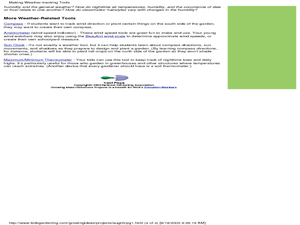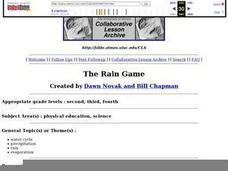Curated OER
Bringing Rain
Students research folklore and scientific information about rain and water cycles. Then they communicate their understanding of water cycles by creating mobiles showing each stage. Students also write their own folk tales, explaining the...
Curated OER
Storms and Extreme Weather
Young scholars explore hurricanes and tornadoes by conducting an experiment. In this weather pattern lesson, students define many extreme weather vocabulary terms and discuss the relationship with static electricity. Young scholars...
Curated OER
Watch the Sky: Observing Clouds and Patterns
Young scholars observe clouds outside of the classroom. In this weather instructional activity, students investigate and record the clouds above their classroom everyday for three weeks. The young scholars then analyze their data and...
Curated OER
Making Weather-Tracking Tools
Students build tools to help track the weather. In this weather lesson, students follow directions to build a rain gauge, barometer and hair hygrometer.
Curated OER
The Water Cycle (Evaporation, Condensation, Precipitation)
The 3 steps of the water cycle, evaporation, condensation, and precipitation, are the focus of this lesson plan. After a neat demonstration of rain using hot water, a pie tin, and ice cubes, young scientists observe and discuss the...
Curated OER
Daily Weather Calendar
Third graders use the internet to record the daily weather conditions. Using symbols, they take the information they gathered and create an easy to read chart. They share their charts with the class to end the lesson.
Curated OER
Windbreakers; Earth Science, Topography, Weather
Learners consider how topography affects weather and human activity. Students simulate a mountain range and observe surrounding wind patterns.
Curated OER
Compare and Contrast
Students learn about similarities and differences between different types of weather patterns. In this weather lesson, students read Cloudy With a Chance of Meatballs and Weather. Students create a word search puzzle, complete a Venn...
Curated OER
Weather Symbols
Students study weather symbols. In this weather symbols instructional activity, students review the symbols for cold, warm, and stationary fronts. Students use a weather map to study the weather symbols, complete a weather illustration...
Curated OER
The Rain Game
Students simulate the precipitation process by playing a game. They simulate the behavior of actual cloud drops and rain drops.
Curated OER
Weather and Climate
Students identify the words plain and climate and discuss what would happen if it never rained. Students identify and interpret the weather in Poland and create a web illustrating various weather patterns. Students write a 4-line poem...
Curated OER
Understanding Cloud Formation
Pupils read and relate the poem, "Clouds" by Aileen Fisher to a demonstration on cloud formation. They create clouds in jars using ice water and matches then discuss the ways clouds can be used to predict weather.
Curated OER
Moon: NC Summer Tour Lesson 2007
Young scholars investigate craters and marea. In this crater and marea lesson, students conduct an experiment to create craters. Young scholars participate in a dance activity.
Curated OER
Ecology: Factors Influencing Animal Populations
Young scholars assess the factors affecting animal populations. Working in groups they define specific vocabulary terms and complete several activities from "Project Wild."
Curated OER
Science: The Water Cycle
Students examine the various stages of the water cycle. In groups, they complete a hands-on activity by creating model water cycle. Students design posters representing each of the seven stages of the water cycle.
















